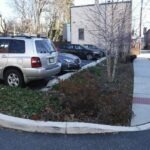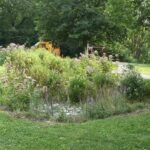Green Infrastructure
Green infrastructure (GI) enhances the natural environment to manage rainwater where it falls, allowing water to soak into the ground, evaporate into the air or collect in storage units. Examples of GI include porous asphalt, rain gardens, bioswales, trees, and green roofs, among many other green technologies.
As with traditional infrastructure, GI requires regular operations and maintenance (O&M) activities to ensure proper functionality. The City’s Green Infrastructure O&M Plan, a component of the City’s green infrastructure plan “GreenIt! Lancaster,” serves as a reference for City field staff, other City agencies and partners, GI designers, the development community, and interested members of the public.
- The GI project installed at the parking lot of the Community Mennonite Church features porous asphalt, attractive plantings, and new trees.
- Bioretention areas such as this rain garden at Brandon Park serve to enhance biodiversity and attract pollinators in addition to managing stormwater.
- Porous paver parking lanes on Mulberry Street.
Monitoring for Improved Performance
By monitoring existing green infrastructure sites, the City is evaluating the performance of green infrastructure and gathering lessons learned regarding GI siting, design, construction, and maintenance so that we can continually improve our program. For more on the City’s GI Monitoring program, see the GI Monitoring Plan below under Documents & Resources.
GREEN IT! LANCASTER
The City’s investments in green infrastructure are guided by Green It! Lancaster, a 25-year plan for improving water quality in the Conestoga River, reducing pollution and excessive flows from our MS4 and Combined Sewer System, achieving cost effective compliance with regulatory obligations, and reinforcing our position as a national and statewide leader. Visit www.cityoflancasterpa.gov/stormwater-information/greenit-lancaster for more information.
Economic Benefits
A 2014 Case Study of Lancaster, PA entitled “The Economic Benefits of Green Infrastructure” documented the many economic benefits associated with implementing green infrastructure in the City. These benefits include:
Water-Related Benefits: Green infrastructure practices such as green roofs, tree planting, permeable pavement, bioretention, and rainwater harvesting help to reduce the volume and rate of runoff entering sewer systems. In combined sewer systems such as Lancaster’s, this could reduce both the storage and treatment required to manage CSOs. This, in turn, could reduce both the capital and operational costs of gray infrastructure systems such as storage tanks and pumping stations.
Energy-Related Benefits: Green infrastructure features such as green roofs, tree planting, and rainwater harvesting reduce energy usage and costs by helping to dampen daily temperature variations in buildings, providing shading, wind blocking, and evaporation benefits, and reducing potable water use and associated energy demands.
Air Quality-Related Benefits: Planting trees and installing green roofs, permeable pavement, and bioretention and infiltration practices can help reduce air pollutants through direct up-take and absorption, reduced electricity generation, and reduced ozone and smog formation.
Climate Change-Related Benefits: Green infrastructure
vegetation helps reduce the amount of atmospheric CO2 through direct carbon sequestration, reductions in water and wastewater pumping and treatment and the associated energy demands, and reductions in building energy use.
Additional Qualitative Benefits: additional benefits include reduced urban heat island effect, increased property value, reduced noise pollution, increased recreational opportunities, habitat improvement, public education, and community cohesion.
A copy of the full report can be found below, under Documents and Resources.



